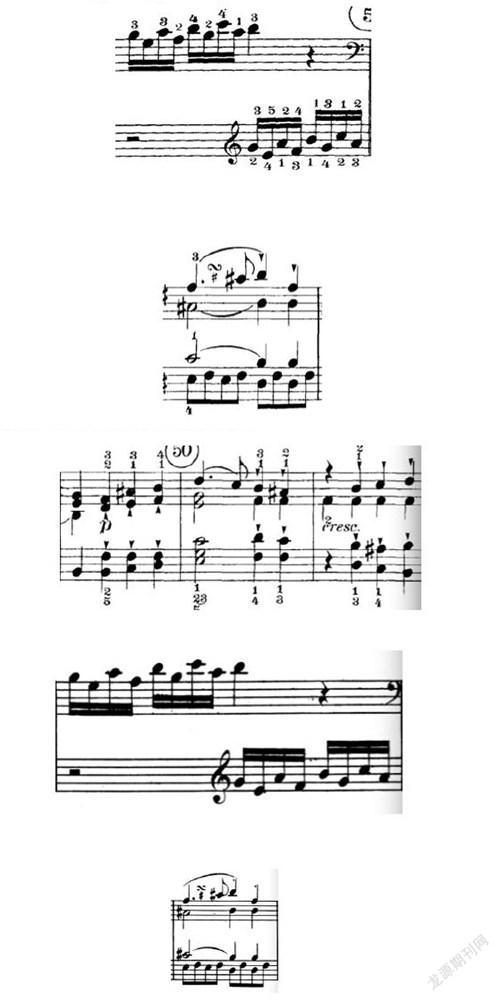Comparison of two performance versions in Beethoven piano sonata Op.14 no.1, 1st movement
2019-09-10蓝熹


【Abstract】This essay is a research about two performance versions in Beethoven: piano sonata No.9 in E major, Op.14, No.1, 1st movement, played by Richard Goode and Daniel Barenboim. It will be separated into four parts in discussion: musical background, editions analysis, interpretations comparison and conclusion.
【Key words】Performance version; edition analysis; Beethoven piano sonata
【作者簡介】 蓝熹(1991.08-),女,汉族,广东广州人,广东第二师范学院,助教,硕士研究生,研究方向:钢琴教学法。
I. Musical Background
As we know, Ludwig van Beethoven was one of the most significant composers in classical period and he was also a pioneer of Romantic period. Particularly worth mentioning was his 32 piano sonatas, which composed during his whole life, and was called “The new testament” in western musical history. Piano sonata Op.14 No.1 composed by Beethoven during 1798-1799, was one of the sonata pieces in his early composition period. Although it’s not as much famous as Piano Sonata No.8 in C minor, Op.13 -“Pathétique”, it was transcribed into String Quartet by Beethoven himself. During his early composition period, Beethoven’s work was not only maintained but his work also elevated the classical traditional features, which were modest, serious and full of philosophy, developed from Haydn and Mozart. There are lots of dynamic, musical expression marks in his works, which are different from Haydn and Mozart’s. Since these dynamics and emotional elements, one can find a great deal of editions written by musicologists and pianists, adding their own feeling and understanding based on his Autography. So, choosing a credible edition which can help performance to know composer’s intension, is the most indispensable part before playing on the piano.
II. Editions analysis
In all different types of editions, I have chosen Doven Publications edition, edited by Heinrich Schenker(1868-1935) and Breitkopf & H?rtel, Ludwig van Beethovens Werk edition, first publication by New York: Edwin F. Kalmus n.d(after 1933), which is an Urtext as models to do a comparison and analysis in edition.
i. Doven Publications edition (1975)
a) Fingering
In Doven edition, the editor Heinrich Schenker, who has added his suggesting fingerings on most of notes.
Bar 5:
b) Slurs
As a four-part sonata, this edition adds slurs to separate different parts.
Bar 39:
c) Accent mark
In Doven edition, editor transcribed some parts of the Staccato mark into Accent mark.
Bar 50-52:
In my opinion, the Doven edition might be suitable for primary learner but it is, clearly, not the most proper score in research and analyze.
ii. Breitkopf & H?rtel , Ludwig van Beethovens Werke edition
a) Fingering
It’s no more fingering except for composer’s mark on the piece.
Bar 5:
b) Slurs
It doesn’t have slur in the inner voice different from Doven edition in Bar 39.
Bar 39:
c) Accent marks
There are no accent marks instead of the Staccato marks on it.
Bar 50-52
After the comparison between these two editions, I chose Breitkopf & H?rtel , Ludwig van Beethovens Werke edition as my reference. Because the Urtext is clear with no more editor markings and it is closer to composer’s intension.
III. Interpretations comparison
From a great number of pianists performed the piece of Beethoven piano sonata No.9 E major, Op.14 no.1, Richard Goode and Daniel Barenboim’s interpretations are chosen to discuss.
i. Brief introduction about pianists
Richard Goode(1943-), who is known for his interpretations of Beethoven and chamber music. He has been hailed for music making of tremendous emotional power, depth and expressiveness, and has been acknowledged worldwide as one of today’s leading interpreters of Classical and Romantic music. His interpretation can stay a properly historical perspective, especially his performances in Beethoven sonatas.
Daniel Barenboim (1942-), who is not only a good pianist but also an outstanding conductor in the world. In 1954, he made his first notable classical recording, included the complete cycles of Mozart’s, Beethoven’s sonatas, etc. Because he is a conductor and has learnt a range of music theories from classical to contemporary period, his performance style is not as much formal and serious as Goode or other classical pianists.
Based on their musical background and achievement, I believe that these two pianists can be models to do a research on the performance of Beethoven piano sonata. According to the recordings about their performances, it will be divided into 3 aspects to discuss: tempo, articulation and tone.
ii. Interpretations comparison
a) Tempo
On the score, the 1st movement tempo mark is Allegro, which means it should be in a brisk and lively tempo during this whole piece. Since this sonata belongs to the early life work of Beethoven, which should be in the prosperity of classical period, the tempo must be steady and serious. In Goode’s interpretation, he creates a good model on steady tempo. Each quavers and semiquavers are even, articulated and vivid. As for the crotchets, half notes and even the rests can play in full value. While in Barenboim’s playing, his tempo is a little bit slower than Goode’s and not steady and serious on tempo, rhythm and value. For instance, bar 5 to bar 6, four parts of semiquavers alternant repeated, he played faster than the original tempo. On the other hand, he played not enough value on the rests, like quaver rests, instead of the staccato crotchet last for nearly a dotted crotchet value. Another example about the rest is in bar56. He gives some rit. to extend the minim rest, which he might want to deal with the dramatic and emotional expression.
b) Articulation
In classical period, articulation plays a vital role in musical technique. A note with staccato marks should not be played leap but detach. In this sonata’s first four bars, right hand is the melody line and the left hand repeats the quaver chords as bass, which can promote the melody development. In Goode’s interpretation, he plays more staccato and clear quavers on the left hand. It sounds like a strongly powerful rhythmic to improve the melody. However, Barenboim didn’t play in staccato but detach, and he also adds a little bit pedals on it. That makes the sound soft and light.
It is worth to mention that this sonata is a formal four-part piece. So, performer should play clearly in each part, like a string quartet. In bar 7 to 12, Goode’s interpretation plays clearly in each part. He not only focuses on the top line melody but also accented the bass at the same time. While in Barenboim’s interpretation, he focuses more on the melody and ignores other parts even the bass.
c) Tone
In this sonata, Beethoven intended to give us a bright, enthusiastic, mysterious work. Goode plays in staccato, even and serious rhythm, making the sound more bouncier and “traditional classical”. On the contrary, Barenboim interprets in relatively free rhythm and adds pedals to connect the phrases. That makes the sound mild, colorful and more “romantic”. As for pedal, in classical period, we can use it to decorate the music but cannot influent the musical style. Throughout the whole piece, Barenboim uses it on the same staccato notes and legato phrases. For instance, bar 70 to 78, there is a long crescendo and dramatically stay on p at the end of this phrase. Goode plays it without pedals and gives even, clear and rapid semiquavers accompaniment, while Barenboim uses pedal to connect the phrase. It makes the sound smoothly to sufficiently express the theatrical emotion, but not clear and even in semiquavers.
IV. Conclusion
After the comparison between Richard Goode and Denial Barenboim’s interpretations of Beethoven sonata in No.9 E major, in terms of the tempo, articulation and tone, I prefer Goode’s work. It is more approachable to Beethoven’s intention and it were compatible to classical music style than Barenboim’s interpretation, which, instead, is more romantic, free and expressive.
References:
[1]Henahan, Donal. Recital: Barenboim plays Beethoven Sonatas[J]. New York Times, Feb,24,1986.
